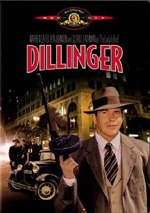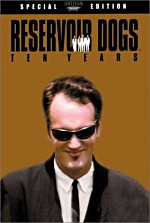|
WARNER
|

| |
|
MOVIE INFO
|
|
Director:
Max Nosseck
Cast:
Lawrence Tierney, Edmund Lowe, Anne Jeffreys, Eduardo Ciannelli, Marc Lawrence, Elisha Cook Jr., Ralph Lewis, Elsa Janssen, Ludwig Stössel
Writing Credits:
Philip Yordan
Tagline:
His Story Is Written in Bullets, Blood and Blondes!
Synopsis:
Willie Sutton robbed banks during the Depression because, he explained, "That's where the money is." Former Indiana farmboy John Dillinger also knew where the money was. And his string of early-1930s heists, murders and daring jailbreaks were so bold and notorious he became Public Enemy #1.
Dillinger, Oscar-nominated for its screenplay, is the bullet-paced story of the man whose crimes captivated and terrified the nation. Lawrence Tierney plays the title role, breaking free of screen anonymity and moving into a 50-year tough-guy career that would include 1947's Born to Kill and 1992's Reservoir Dogs. Perhaps it was a brutal early prison stretch that turned Dillinger from kid to killer. Perhaps he was a murderous thug to his core. Either way, Dillinger presents his story with film-noir style and lets you decide.
Box Office:
Budget
$193.000 thousand.
Domestic Gross
$4.000 million.
MPAA:
Rated NR
| |
|
DVD DETAILS
|
Presentation:
Fullscreen 1.33:1
Audio:
English Monaural
Subtitles:
English
Spanish
French
Closed-captioned
Runtime: 70 min.
Price: $19.97
Release Date: 7/5/2005
Bonus:
• Audio Commentary with John Milius (Director of the 1973 Dillinger) with Audio Interview Excerpts from Screenwriter Philip Yordan
• Trailer
| |
|
PURCHASE @ AMAZON.COM
|

| |
|
EQUIPMENT
|
Sony 36" WEGA KV-36FS12 Monitor; Sony DA333ES Processor/Receiver; Panasonic CV-50 DVD Player using component outputs; Michael Green Revolution Cinema 6i Speakers (all five); Sony SA-WM40 Subwoofer.
| |
|
RELATED REVIEWS
|


| |
[an error occurred while processing this directive]
|
Dillinger (1945)
|
|
Reviewed by Colin Jacobson (July 1, 2005)
For a gangster flick, 1945’s Dillinger starts in an odd way. We see an audience watch some “highlights” of John Dillinger’s (Lawrence Tierney) criminal career before his father (Victor Killian) comes out to speak to them. Pa Dillinger provides some very basic details of his son’s life and then we actually view John after he sets out on his own. Apparently a floozy drove him to a life of crime, as he robs a corner store to get the two dollars to buy her a drink. The incompetent crook immediately runs into a cop and ends up in the pokey.
In prison, Dillinger lives with cellmate “Specs” Green (Edmund Lowe), a skilled bank robber. Once he learns of Specs’ deeds, Dillinger tries to dig out as much criminal information as he can. Specs teaches Dillinger the ropes. A big thinker, Dillinger starts to plan for his own gang when he gets out of jail.
Back on the streets, Dillinger flirts with a ticket seller at a movie theater - and then robs her. Initially she does the right thing and picks him from some mug shots, but she lies and says she can’t identify him when he goes in a lineup. Dillinger then takes Helen (Anne Jeffreys) on a date. While romance blooms, Dillinger goes ahead with his plans to free Specs and his other prison buddies.
This succeeds and the Dillinger gang takes flight, though John still defers to his mentor Specs. They soon commit robbery after robbery and become a sensation. Soon John starts to take more and more control of the gang, much to the chagrin of Specs. The movie follows Dillinger’s exploits and what eventually happens to him.
Most folks of my generation know Tierney from his tough guy roles in Reservoir Dogs and as Elaine’s dad on Seinfeld. Dillinger shows the genesis of that personality, though the much younger Tierney seems nearly unrecognizable. As mentioned in Dogs, the 70-something Tierney looked like the Thing from the Fantastic Four. That makes it odd to see him as a much younger, much handsomer man.
Not that Tierney was ever quite “leading man handsome”; he was certainly attractive, but in a somewhat gruff, off-putting way. That made him perfect for the Dillinger character, at least as depicted here. How much of Dillinger connects with historical reality remains to be seen, but frankly, I can’t say this issue matters much to me. 1973’s Dillinger almost certainly presents a more accurate portrayal of the gangster’s life, but it lacks many other positive attributes. I’m more interested in whether or not the end product provides entertainment, and in this case, it certainly does.
Much of the credit for the film’s success goes to Tierney. He conveys real menace in the lead role but he also adds charm, and that allows us to see the character as more than just a thug. Cool and understated, Tierney does a lot with just a glare. He’s a truly believable tough guy.
Shot on the cheap, Dillinger looks like a bargain “B” movie and it suffers from a surfeit of storytelling problems. The whole set-up with Pa Dillinger is odd and pointless, especially since we never hear from him again. Characters come and go at random, especially in regard to Helen; she’s there one minute but forgotten the next. Frankly, in this regard, the movie’s something of a mess.
However, Dillinger sticks to its basic plot well enough to make the film work. It’s about little more than the lead character’s rise and fall, and it stays with that strongly enough to hold together. The flick’s brevity acts as a positive as well; it flies by so fast that it’s difficult for the flaws to make much of an impact.
No one will mistake Dillinger for one of the best gangster films, but don’t dismiss it for its cheap “B-movie” nature. Largely due to an excellent lead performance from Lawrence Tierney, it provides a lively and entertaining piece.
|
The DVD Grades: Picture C-/ Audio C/ Bonus C
|
|
Dillinger appears in an aspect ratio of 1.33:1 on this single-sided, single-layered DVD; due to those dimensions, the image has not been enhanced for 16X9 televisions. Even for a 60-year-old flick, Dillinger suffered from too many problems to earn an above-average grade.
Print flaws caused virtually all of the concerns. Dillinger teemed with source defects. Specks and small marks popped up very frequently. In addition, I saw occasional examples of blotches, tears, streaks, scratches, and nicks. At times the frame jumped quite a lot. This was most prominent during the robbery of the Fifth National Bank, but other “bobbing frame” shots occurred as well. Some parts of the movie came across as relatively clean, but many suffered from a surfeit of blemishes.
That was too bad since the rest of Dillinger looked good. A few slightly soft images appeared, but those failed to create distractions. Instead, most of the movie demonstrated nice definition and delineation. I saw no issues with jagged edges or shimmering, and only a slight amount of edge enhancement appeared.
Blacks came across as deep and rich, while low-light shots demonstrated solid clarity. The movie usually displayed a fine contrast that abetted the black and white visuals. I debated whether to give Dillinger a “C-“ or a “D+”, as I found it hard to give a transfer with so many source flaws a grade over “D” level. I thought it deserved the higher mark simply because every other aspect of the image was positive, but one should still expect a lot of defects here.
While the monaural soundtrack of Dillinger didn’t suffer from such obvious concerns, it did nothing to distinguish itself from other flicks of its era. Speech usually came across as somewhat thin and brittle. Edginess was a real problem, but the lines lacked bite. They remained perfectly intelligible, even with minor hiss that cropped up with most of them.
Effects presented acceptable clarity given their age but failed to go above that. Range remained predictably limited, as louder elements like explosions demonstrated little heft. They were just fine for material of this era, as was the score. Again, the music tended to be fairly tinny and restricted, but not badly so. In addition to the hiss, some examples of pops accompanied the audio. The track stayed okay for a flick from 1945 and failed to impress me as anything above average.
In addition to the film’s trailer, we find an audio commentary with John Milius - the director of the 1973 version plus “audio excerpts” of screenwriter Philip Yordan. Milius presents a running, screen-specific piece that occasionally breaks away for remarks from Yordan. The latter only occurred a few times and ceased about a third of the way into the movie.
Milius offers little of use. He mainly makes general comments about the 1945 film and periodically discusses its historical accuracy - or lack thereof - along with minor notes about the cast and crew. Unfortunately, the latter tend to be virtually useless; for example, when he mentions that we’ll recognize Edmund Lowe from many films, he doesn’t bother to identify any of them. He often simply sits silent or reiterates lines from the movie right after we hear them.
Milius doesn’t seem to know much about the movie. He speculates about it but can’t relay any facts related to it. His remarks about the real Dillinger are useful, but they pop up so sporadically that they don’t give us much depth.
Happily, Yordan’s remarks prove more beneficial. He talks about casting and Lawrence Tierney, the script, and the Hollywood blacklist. The information Yordan provides is good, but he pops up so infrequently that they can’t dent the boredom that comes from Milius’s remarks. Listen to the track until Yordan makes his last stand; don’t bother with it after that.
A good, simple little gangster flick, Dillinger lacks much polish, and its low budget comes through in spades. Despite a mix of flaws, it still delivers a fast-paced film that socks you in the gut. The DVD is pretty bland, unfortunately. Picture and sound quality are at best average for the era, and the extras don’t shine either. I like the movie enough to recommend at least a rental, however.
|
|
Viewer Film Ratings: 2.5 Stars | Number of Votes: 6 |
|
|

